Korean seaweed side dish that’s made from Miyeok Julgi (stem). A great savory and garlicky banchan that is really easy to make. A perfect way to enjoy the full flavors and nutrition of this wonderful sea plant. Vegan and Gluten-Free.
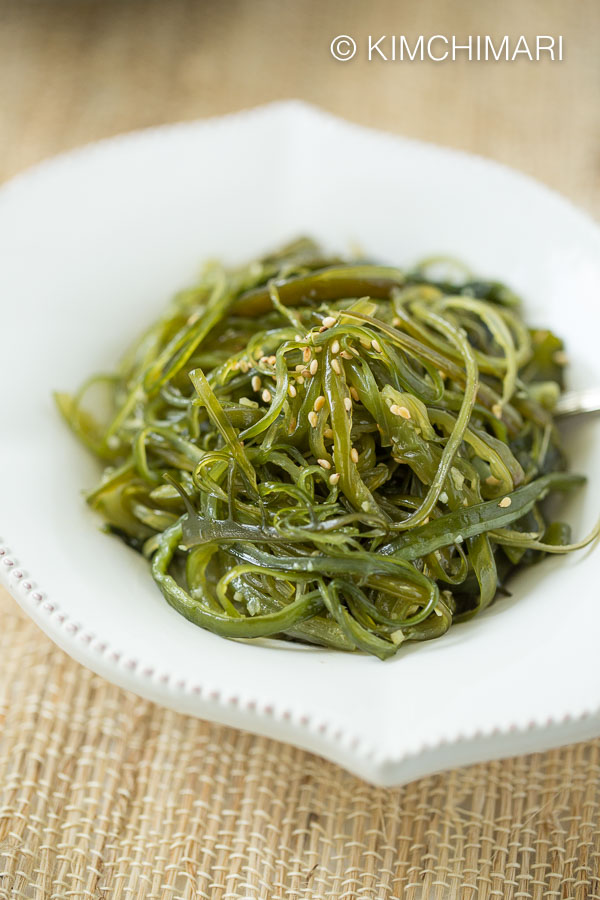
Korean Seaweed Side Dish (Miyeok Julgi Bokkeum 미역줄기볶음) is a dish that I almost always eat first whenever it’s served at a Korean restaurant.😝 Because..it’s so mild and nutty flavor, it is a great side dish to just snack on until you wait for your food to come. 😉And wouldn’t you say this is one of the most common side dish at US Korean restaurants other than Kongnamul??
So interestingly, this Miyeok Julgi Bokkeum is NOT something I grew up with. I don’t know why I never had it growing up, it may be because this is a very popular dish in Jeolla Namdo but probably not in Northern Korea. And I feel like it is much more commonly served at Korean restaurants in the US rather than actually in Korea. I have no idea why.. if you have a theory, let me know! HAHA..
Anyway, when it comes to Korean banchan made from these wonderful seaweed stems, there are basically 2 kinds – one that is savory (the one in this post) and the other that is like a salad with a sweet and tangy dressing which is also often called Miyeok Muchim. I love both, which one do you like?? For those of you who like the sweet vinegary cold salad type, yes, I will post that sometime later.
What’s Miyeok Julgi 미역줄기?
Miyeok (Undaria pinnatifida), also called the Sea Mustard, Brown Seaweed or Wakame (in Japanese), is kind of a large seaweed that can grow very tall and the whole plant is eaten including the stems (not the root). Miyeok Julgi is the stem of the Sea Mustard.
Normally, miyeok comes in a dried form and Koreans love to eat the whole miyeok by making Miyeok Guk (soup) with it – including the stems. But Miyeok Julgi are just the stems of the miyeok, cut out and then sliced thin for convenience.
Health Benefits of Miyeok or Wakame Seaweed
As I have mentioned in my Miyeok Guk post, Seaweed is traditionally given to new mothers to help them recover from childbirth and also to increase breast milk production. Seaweed also has high levels of minerals like iodine, manganese, folate, magnesium and calcium to help you meet your nutrient needs. Note, the level of iodine is high enough that if you have hyperthyroidism it is recommended that you consult your doctor before you eat it.
Miyeok (Sea Mustard) is also high in fiber and is also known to help with constipation. It also contains good amount of vitamins A, C, E and K, as well as iron, copper and phosphorus.
How to buy good Miyeok Julgi and prepare it?
I know every store will be different but I found 2 different kinds of Miyeok Julgi in my local store. Whenever I buy Korean ingredients, I usually try to buy products that were made or grown in Korea. 한국산 Hanguksan or 국산 Guksan is what you should look for. Remember they have gotten sneaky these days and sometimes will say ‘packaged in Korea’ but maybe using ingredients imported from other countries.
I don’t say this because I feel Korean products are always superior (although I have to tell you Koreans make pretty high-quality goods these days). I say this because we are making Korean food so naturally, produce grown in Korea will be better suited for Korean cooking.
For example, here are the two packages I bought to see if there are any differences.
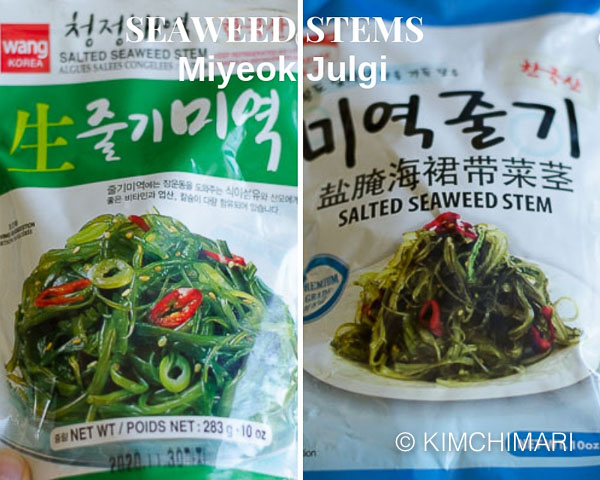
I found them to be similar but I found the one on the left to be a little more tough, stringy and thicker in general. And for some reason, the left one was also very looong whereas the one on the right was pre-cut already to a perfect size which did not need to be cut at all.
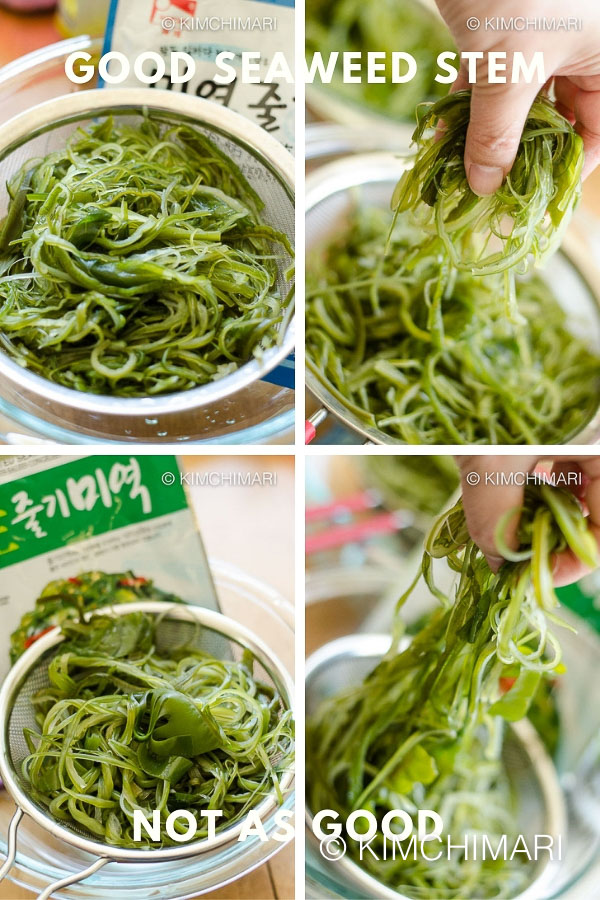
So from these two, buy one by Haitai if you can.
Is my Sauteed Seaweed Side Dish supposed to be slimy?
No. If you make it right, your Miyeok Julgi Bokkeum should not be slimy or gummy. Please note that this recipe is quite simple and easy to do if you follow my instructions. However, I have to confess I messed this up quite a few times at first. My seaweed ended up becoming slimy and gummy which is a property I HATE the most.
TO AVOID SLIMY – DO NOT cook your Seaweed too long or at too low a temperature. MY TIP – USE a BIG enough frying pan (12 inch) OR cook small amount like 1/2 of a 10 oz package for smaller frying pan.
Tips for Best Seaweed Side Dish (Miyeok Julgi Bokkeum)
- Use Good Quality seaweed stem produced in Korea that are not too tough
- For softer, less chewy miyeok julgi, try blanching the seaweed in boiling water for 10-20 seconds. Personally, I didn’t like the texture when I tried it with these 2 kinds above but you may want to make it softer for whatever reason.
- For extra nuttiness, you can add some perilla seed powder (Deulkkae Karu 들깨가루).
- IMPORTANT – Use a good size frying pan. See my tip above to avoid SLIMY results.
- SERVING SUGGESTIONS
- Serve at room temperature or even cold from the fridge.
- Great side to any meal, especially one that has spicy and strongly seasoned soups or jjigae.
- STORAGE
- Store leftovers in the fridge up to a week. No need to reheat.
Step-by-Step Instructions
- Take the seaweed stems out of the package. They will come heavily salted.
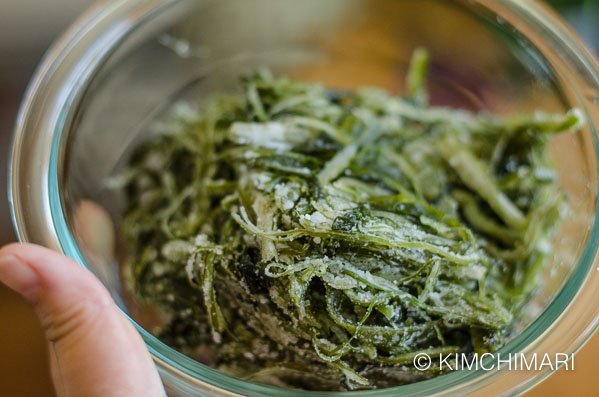
Salted Seaweed Stems (Miyeok Julgi) - Rinse away the salt by shaking them in a bowl of water and draining the water out. Repeat 2 more times for a total of 3 rinses to completely rinse out any sea salt crystals.
- In a bowl of fresh water (enough to totally immerse the seaweed and more), add the rinsed seaweed. Let it soak for at least 30-40 minutes.

seaweed stem miyeok julgi in water - Taste the soaked seaweed stems to test if enough salt has been drawn out. At this point, they should taste not salty at all. DRAIN.
- Chop some fresh garlic and measure out cooking sake, oil, salt and sugar.
- Heat up sesame oil + vegetable oil in a frying pan on medium-high heat.
- Add the drained seaweed and saute on medium-high heat for 1-2 minutes, making sure everything is well coated in oil.
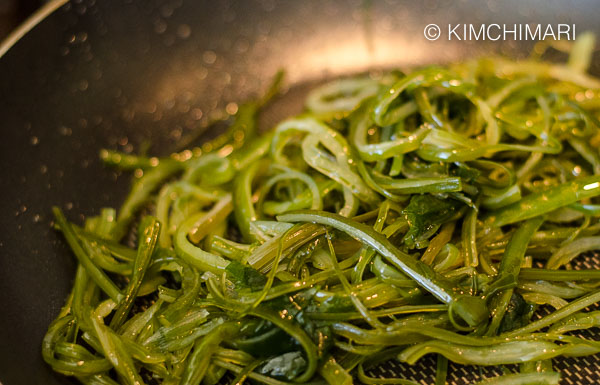
Sauteeing seaweed in frying pan with oil - Reduce heat to medium and then add chopped garlic and cooking sake.
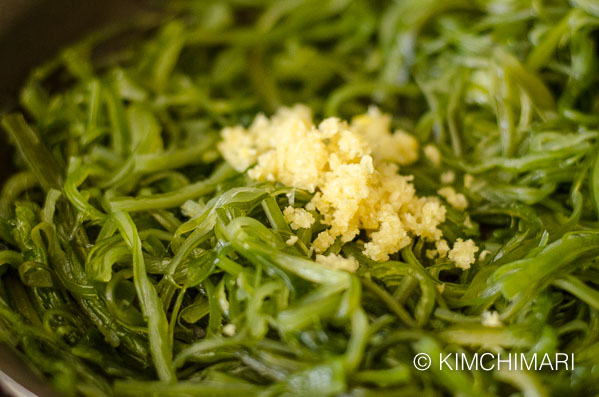
Garlic added to Seaweed in pan - Sauté for about 1 minute until all the garlic is evenly mixed in.
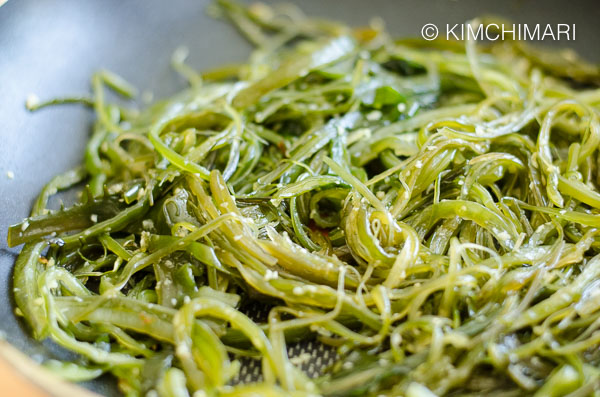
seaweed stems sauteeing in pan - Add salt. Because your seaweed may have different levels of sodium, I recommend starting with just 1/2 the amount of salt. Taste. Then add more to taste.
- Finally, add sugar. Mix and saute for another 30 seconds to a minute. It should NOT taste sweet but just enough to make it yummy. Adjust seasoning to your taste.
- Transfer sauteed Miyeok Julgi Bokkeum to a plate or container.
- Sprinkle sesame seeds and serve. Optionally, sprinkle some chopped green onions for color. There you go!! Enjoy!!
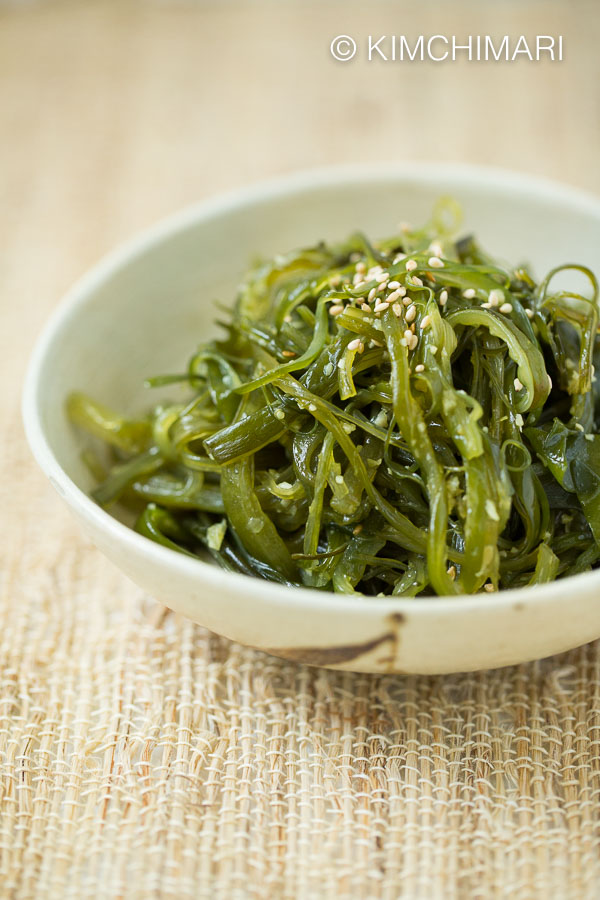
If you want to try other Vegan and Gluten-Free Korean Recipes, check out my post here –
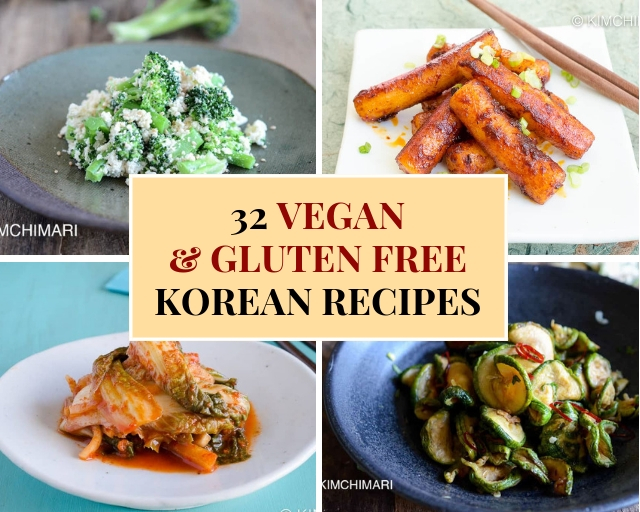
If you have tried this Korean Seaweed Stem Side Dish (Miyeok Julgi Bokkeum) or any other recipe on my blog then please rate the recipe (top right of the recipe card) and leave me a comment to let me know how you like it! Every 5 star helps me a lot and I also love to hear from you! 😍
You can also FOLLOW ME on FACEBOOK, PINTEREST and INSTAGRAM or join my FACEBOOK GROUP to see other Korean recipes to ask and share everything about Korean food with others just like you!
Enjoy!
XOXO ❤️,
JinJoo
Korean Seaweed Stem Side Dish (Miyeok Julgi Bokkeum)
Ingredients
- 1 pack seaweed stems (miyeok julgi 미역줄기) (10 oz / about 280g)
- 1 tsp vegetable oil
- 1 tsp sesame oil
- 2 tsp garlic (chopped)
- 1 Tbsp cooking sake (or mirin)
- 1/3 tsp sea salt (more or less to taste)
- 1/4 tsp sugar or more to taste
Instructions
- Take the seaweed stems out of the package. They will come heavily salted.
- Rinse away the salt by shaking them in a bowl of water and draining the water out. Repeat 2 more times for a total of 3 rinses to completely rinse out any solid sea salt crystals.
- In a bowl of fresh water (enough to totally immerse the seaweed and more), add the rinsed seaweed. Let it soak for at least 30-40 minutes or even longer if you want to draw out more salt.
- Taste the soaked seaweed stems to test. After soaking, they should taste not salty at all. DRAIN.
- Chop some fresh garlic and measure out cooking sake, oil, salt and sugar.
- Heat up sesame oil + vegetable oil in a frying pan on medium-high heat.
- Add the drained seaweed and saute on medium-high heat for 1-2 minutes, making sure everything is well coated in oil.
- Reduce heat to medium and then add chopped garlic and cooking sake. Saute for about 1 minute.
- Season by adding salt. Because your seaweed may have different levels of sodium, I recommend starting with just 1/2 the amount of salt. Taste. Then add more to taste.
- Finally, add sugar. Mix and taste. Adjust seasoning to your taste. Turn heat off.
- Sprinkle sesame seeds and serve.
Tips & Notes:
- SERVING SUGGESTIONS
- Serve at room temperature or even cold from the fridge.
- Great side to any meal, especially one that has spicy and strongly seasoned soups or jjigae.
- STORAGE
- Store leftovers in the fridge up to a week. No need to reheat.
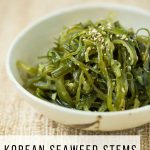
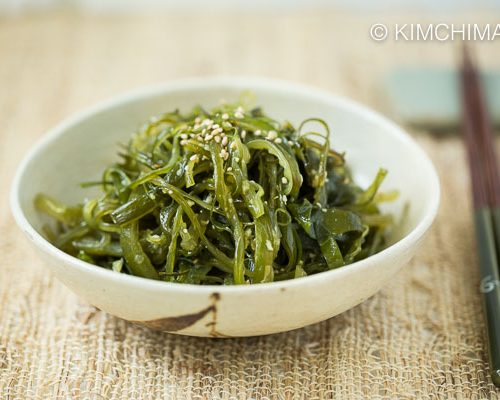
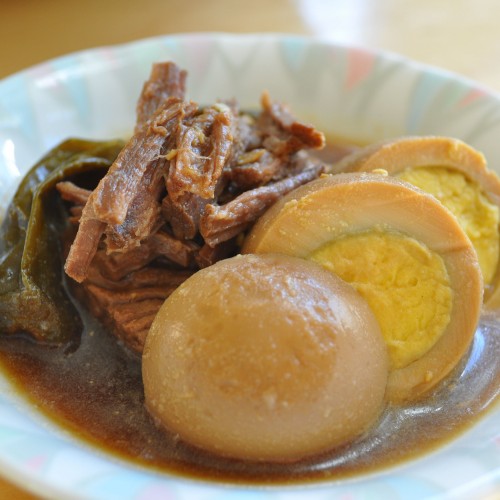
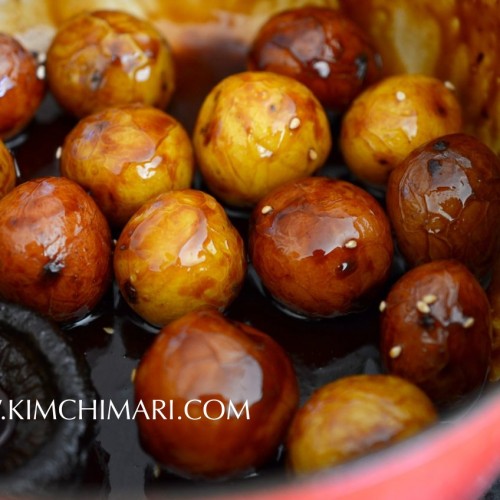
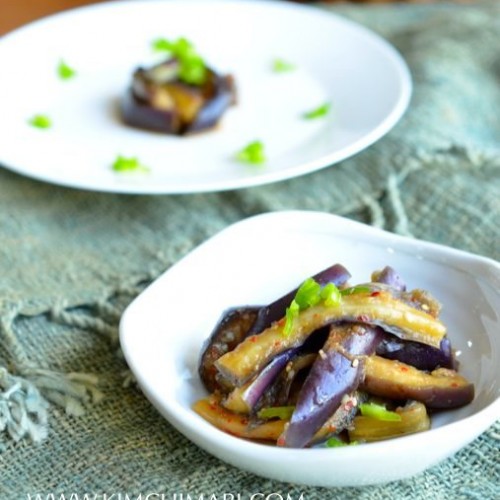
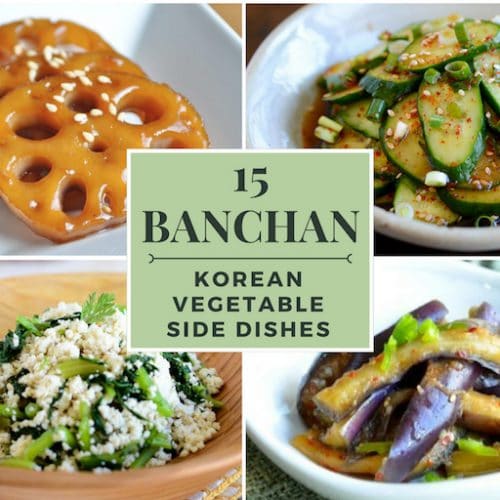
















I enjoyed making this and it ended up being so good. i did buy the wrong version and had to cut them myself so theyre a bit thicker than the pictures here. mine did not need any extra salt though ahah but i did everything else and it was great!
Wonderful!! I’m glad you enjoyed it. Thank you for the 5 stars too!
Your instructions say, “Finally, add sugar.” But your ingredient list does not say any sugar. How much sugar should we add?
Oh dear!! Sorry not sure what happened there. Just add about 1/4 to1/2 tsp sugar. Just enough to balance out the saltiness but should not taste “sweet”. Thank you for asking!!
Excited to try this. What aisle is the seaweed typically found? Is the seaweed in the frozen food or with nori/kelp sheets? I’m such a fan of your blog, I reference it constantly while shopping g!
Hmm hard to say but usually it should be near dried foods aisle where you will have dangmyeon ( sweet potato noodles). Thank you so much – I am going to try to add more reference stuff on my web site soon so please stay tuned!! Thank you.
Healthy food to have.
And you made this healthy food delicious too.
Thanks for sharing such a wonderful recipe.
Keep Posting !!
Looking forward to know more from you .
Thank you thank you! Will be posting more – make sure you subscribe to my newsletters because I share menu ideas and cooking tips there too!!
YAY! I was waiting on this recipe!! Thank you JinJoo! Now I have to go shopping lol
YES Marlena!! I made it just for you!! Thank you! Enjoy!